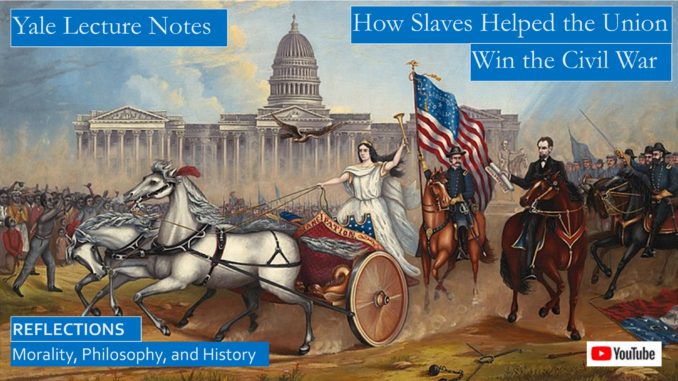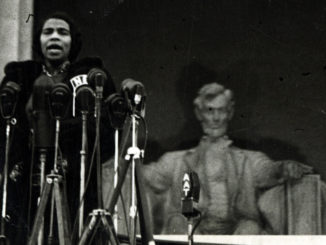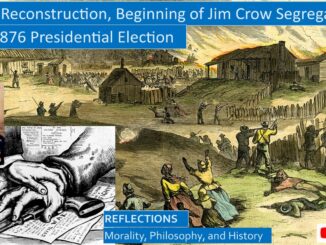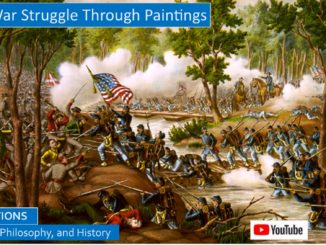
How can so many church goers blindly support Trump although Trump is the antithesis of Christianity? Many Christians who feel alone in their opposition find hope in this editorial of the leading magazine Christianity Today:
https://www.christianitytoday.com/ct/2019/december-web-only/trump-should-be-removed-from-office.html
The objective of these blogs are to educate the reader about the history of Jim Crow and the civil rights struggles of America. This was a bloody history, the prospect we might regress closer to the days when blacks were brutally lynched without any hope that the murderers would be brought to justice is frightening. This callousness was enabled because many whites in this bygone culture did not see blacks as real people, whites refused to treat blacks with dignity as equals. So we will try to tell this history with stories showing these blacks and former slaves as real people with dreams, innocent people who truly suffered from many miscarriages of justice.
YouTube script for this blog: https://youtu.be/89ulb20cy8Q
This is our blog on history of slavery in pre-Civil War years:
http://www.seekingvirtueandwisdom.com/american-slavery-and-the-abolitionists-yale-lecture-notes/
This blog also has the links to the free YouTube Yale undergraduate lectures for both Professor Holloway’s African American History class and Professor Blights’ Civil War and Reconstruction class.
This is our blog on how black ex-slaves struggled in the Reconstruction and Redemption eras:
http://www.seekingvirtueandwisdom.com/post-civil-war-reconstruction-and-redemption-history-yale-lecture-notes/
This is our blog on the American Civil Rights history following the Reconstruction and Redemption eras:
http://www.seekingvirtueandwisdom.com/american-civil-rights-history-yale-lecture-notes/
We also encourage you to read our complete set of blogs on slavery in both the Deep South and ancient worlds:
http://www.seekingvirtueandwisdom.com/category/slavery/
When the war began Lincoln insisted that the war needed to be fought to preserve the Union. Lincoln said that if he could abolish slavery and save the Union, he would do that; if he could preserve slavery and save the Union, he would do that.
But preserving the Union was really all about slavery. Northerners were against admitting new states in the western territories as slave states, the various compromises negotiated were either overturned by events or by the Supreme Court. Even if Lincoln had sought a peace treaty with the Confederacy, what would happen to those Western territories?
Lincoln was forced into the war because the Confederacy would not permit Northern ships to resupply Fort Sumter. Lincoln wanted to resupply the fort not with munitions but with food and water. Southern cannons fired on the fort in the bay of Charleston, South Carolina, the first state to secede from the Union.
At the beginning of the war both sides anticipated, maybe hoped is a better word, that the war would only last a few more months. But then month after month, battle after battle, armies advance then retreat, and the casualties mount with no end in sight. But the soldiers from the North were far easier to replace, the South would lose in a war of attrition. The North had more manufacturing, more railroads, more railroads of the same gauge, and a far greater population.
In the beginning the South had the better generals, General Robert E Lee was always a brilliant tactician. Although General McClellan would incessantly drill the raw recruits in the Northern Army, he was a cautious general, letting victory slip through his grasp many times after a hard-fought bloody battle. McClellan was not an abolitionist, he was a peace Democrat who ran against Lincoln in the next Presidential election. But General Grant would win first at Vicksburg, then after Lincoln put him in charge of the Union armies, he would continually flank Lee until he was cornered and surrendered at Appomattox, while General Sherman burned Atlanta and marched to the sea.
The Southern army was never well provisioned. David Blight says this of Lee’s army when they invaded Maryland for the Battle of Antietam:
Lee’s army wasn’t very well fed, and they weren’t very well clad. Here’s one description of a young Marylander who saw the Confederate Army. He said it was nothing but “a set of ragamuffins. It seemed as if every cornfield in Maryland had been robbed of its scarecrows. None had any underclothing. My costume consisted of a ragged pair of trousers,”–this guy apparently joined–“a stained dirty jacket, an old slouch hat, the brim pinned up with a thorn, a begrimed blanket over my shoulder, a grease-smeared cotton haversack full of apples and corn, a cartridge box full and a musket. I was barefooted. I had a stone bruise on each foot. There was no one there who would not have been run in by the police had he appeared on the streets of a normal city.” And there’s plenty of testimony in the record, though a lot of young Maryland men came out to see this now famous army of Robert E. Lee, took one look or one smell, as one put it, and went back to their farms. Lee will get almost no real recruits out of Maryland. What they will do in Maryland, however, is capture several hundred slaves and return them, or take them, to Virginia. They’re going to do the same thing in 1863 in the Gettysburg campaign on an even larger scale. Kidnapping was also part of the Confederate army’s job.[1]
From the beginning of the war, every time the Union forces advanced into the South escaped slaves would cross the Union lines. Some were returned to their masters in the beginning of the war, but most were confiscated as contraband of war. Most of them were put to work doing menial labor for the Union Army, but some of them served as scouts and spies for the Union forces.
Many southerners thought that if they treated their house slaves or urban slaves well that they would readily accept slavery as their lot in life. David Blight tells this story of one such slave who escapes to Union lines:
Back in Virginia there was a young slave, twenty-two years old. His name was John Washington, he had grown up in Fredericksburg, Virginia. He had a white father whom he had never known and a slave mother named Sarah, who taught him how to read and write. He grew up as an urban slave with lots of skills, highly valued, probably a brilliant young man. He was hired out many times as an independent artisan before the war. He married his sweetheart in January 1862 in the African Baptist Church in Fredericksburg. He chose his moment of escape at the first appearance of Union forces along the Rappahannock River in Fredericksburg on the 18th of April, 1862. John, then 22 years old, tells the story of all the white people evacuating Fredericksburg and how his mistress, Mrs. Tolliver, is literally packing her china and her silver, and she says to John, “Now John, you’ll be with us tomorrow, you’ll be with us tomorrow.” She’s assuming his loyalty. And he says, “Yes Misses, yes Misses, I’ll be with you tomorrow.” Then he goes to the hotel where he’s been hired out as a steward and describes all the white people fleeing the hotel and the streets of Fredericksburg. He took the twelve black workers up on the roof of the hotel where they could see across the river “the gleam of the Yankees’ bayonets.” And then he brought them all back down into the kitchen and he poured a round of drinks, and he held a toast, and the toast was “To the Yankees.” And then he instructed his fellow workers, he said, to get out of there. “But,” he said, “don’t get too far from the Yankees.” John Washington spent the rest of that summer as a camp hand and a guide for the Union Army, all the way through Second Manassas.
If you have not seen the movie Harriet, released in 2019, about Harriet Tubman, the escape slave and underground railroad conductor who repeatedly risked her life rescuing hundreds of slaves in the Deep South, you must see the movie. As with all movies, there were a few exaggerations, at the end of the movie they concoct a scene enabling her to give a Thucydides speech to her aggrieved former master, but her incredible bravery and determination could never be exaggerated.
Harriet Tubman also assisted the Union Army in their invasions of the South. Harriet was the first woman to lead an armed assault during the Civil War. From Wikipedia:
When Union troops were planning attacks on South Carolina plantations, Tubman served as a key adviser and accompanied the raid. On the morning of June 2, 1863, Tubman guided three steamboats around Confederate mines in the waters leading to the shore. Once ashore, the Union troops set fire to the plantations, destroying infrastructure and seizing thousands of dollars worth of food and supplies. When the steamboats sounded their whistles, slaves throughout the area understood that it was being liberated. Tubman watched as slaves stampeded toward the boats. “I never saw such a sight”, she said later, describing a scene of chaos with women carrying still-steaming pots of rice, pigs squealing in bags slung over shoulders, and babies hanging around their parents’ necks. Although their owners, armed with handguns and whips, tried to stop the mass escape, their efforts were nearly useless in the tumult. As Confederate troops raced to the scene, steamboats steamed north, packed full of slaves.[2]
For an excellent review of this movie and more about the remarkable life of Harriet Tubman:
https://www.smithsonianmag.com/smithsonian-institution/true-story-harriet-tubman-movie-180973413/
David Blight tells us a story about an escaped slave named George Hatton who had advanced to sergeant in the Colored Troops when his regiment was encamped near Jamestown, Virginia.
Into the Union lines came several black freed women who all declared they had recently been severely whipped by a master. Members of Hatton’s company managed to capture that slave owner, a Mr. Clayton, the man who had allegedly administered the beatings on these women. The white Virginian was stripped to the waist. He was tied to a tree and he was given 20 lashes by one of his own former slaves, a man named William Harris, who was now a member of the Union Army. In turn, each of the women that Clayton had beaten were given the whip and their chance to lay the lash on this slaveholder’s back. “The women were given leave,” said Sergeant Hatton, “to remind him that they were not longer his but safely housed in Abraham’s bosom and under the protection of the Star Spangled Banner and guarded by their own patriotic, though once downtrodden race.” In Hatton’s letter he once again felt lost for words to describe the transformation he was witnessing. “Oh that I had the tongue to express my feelings,” he wrote, “while standing on the banks of the James River on the soil of Old Virginia, the mother-state of slavery, as a witness of such a sudden reverse. The day is clear, the fields of grain are beautiful and the birds are singing sweet melodious songs while poor Mr. Clayton is crying to his servants for mercy.”[3]
As the number of these escaped slaves increased and the need for additional Union soldiers likewise increased, Lincoln and the generals began to ask themselves, Why not induct these former slaves into the Army? They would be eager to bear arms against the masters who had so often whipped and humiliated them.
To win the war, Lincoln drafted the Emancipation Proclamation, shared it with his Cabinet, and then pocketed the document until the fortunes of war improved for the North. After the victory at the Battle of Antietam and Grant’s victory at Vicksburg, Lincoln released the Emancipation Proclamation as an executive order issued under his war powers as Commander-In-Chief in September 1862.
What the Emancipation Proclamation did not do was emancipate any slaves immediately, nor did it emancipate the slaves in the border states loyal to the Union cause. Lincoln proclaimed that if the Confederacy surrendered by January 1, 1863, she could keep her slaves, but if the rebellion persisted after that date all slaves in the rebelling states would be free.
David Blight in his lecture says:
There were at least four immediate and visible effects of the Emancipation Proclamation. First, every forward movement the Union armies now would, whether some of those officers liked it or not, liberate more slaves. Second, news of this Proclamation, whatever the details and the fine print, would spread like wildfire across the South, and it would attract towards Union lines more freed people. We have testimony of Confederate soldiers and white Southerners saying they first heard about the Emancipation Proclamation from their slaves. Third, it committed the United States Government in the eyes of the world to Emancipation. That’s terribly important when we remember that Great Britain was on the verge of recognizing the Confederacy as an independent nation. Fourth, Lincoln formally authorizes once and for all, although it’s already begun to happen, the recruitment of black men into the Union Armies and Navy, and it authorizes a formal process now to recruit black men to the Union uniform. And before the war will end about ten percent of all Union forces will be African American– approximately 180,000–eighty percent of whom were former slaves, from the slave states.
After the Emancipation Proclamation, two years into the war under Lincoln, Congress passed the Conscription Act, America’s first national draft act. The draft was controversial everywhere in the North, especially in New York City. Of all northern cities, New York City had the closest economic ties to the South, New York was a center of the cotton trade with Europe. Many New Yorkers were sympathetic to the Southern cause.
Jonathon Holloway say this in his lecture:
In response to the Union draft, several days of rioting begin in New York City. The military command–commandant of the region, anything embodying military, or suggesting police control, is targeted. They’re targeted by largely ethnic Irish gangs. These gangs also targeted blacks. The commandant calls for more troops. When the dust has settled, as many as a thousand people are dead during these riots.
Professor Holloway continues:
These were bloody riots. We’re not talking about gangs throwing rocks and beating each other up. We are talking about lynchings. In total, eleven people are lynched during the several days of riots. A few examples: Joseph Reed, separated from his mother and grandmother, he’s beaten to death. He’s seven years old. William Williams, a sailor, assaulted by the longshoremen, the dock workers, when he asked for directions, not knowing this riot is happening. Someone picks up a cobblestone, hurls the stone at him. Someone else stabs him. The crowd cheers, and they start chanting, “Don’t hire niggers! Don’t hire niggers!”
Professor Holloway continues:
The Colored Orphanage, a very large building there to take care of abandoned children, the crowd sees this place as a site of threat–something the blacks have that the Irish don’t. They set the orphanage on fire. Thankfully, the staff and children were able to escape out the back as the building is torched. On the third day of riots, Abraham Franklin, a disabled black coachman, and his sister Henrietta, were pulled out of their boarding room and lynched. Now there’s one thing I forgot to mention that’s important. Blacks and Irish were at each others’ throats through this process, but they’re living in the same areas. They’re interacting all the time, and that’s what makes this story that much more horrific.[4]
After the riots Lincoln decides to leave New York City alone and quietly discontinues the compulsory draft in the city. He reasons that as long as the rest of the country thinks New York City is pulling its weight in the war, that is all that matters.
David Blight relates another incredible story about the young slave Wallace Turnage, whose spirit was never broken even as he was savagely beaten and mistreated following four failed attempts to escape to freedom:
Wallace Turnage was sold to a Richmond, Virginia slave-trader named Hector Davis. He spent about six months in 1860 working in the three-story slave jail/auction house in Richmond. His job every day was preparing the slaves in what was called the dressing room, to take them out to the auction floor. And one day he’s simply told, “Boy, you’re in the auction.” And he was sold to an Alabama cotton planter named James Chalmers. Seventy-two hours later by train he found himself on a huge cotton operation near Pickensville, Alabama, which is right about there, right on the Mississippi border, a plantation with about eighty-five slaves. And the narrative he left us is the story of his five attempts to escape in the midst of the war, the story of a half-crazy teenage slave who just couldn’t be controlled.
Wallace ran away four times into Mississippi, always trying to get up to northern Mississippi to get to the Union armies. One time he was at large for four and a half months, hiding in other slave cabins and hiding in woods and forests and gullies wherever he could hide. He almost reached the big contraband camp in Corinth on his fourth try. He was captured by slave patrols. His master would always come after him because he was so valuable. Chalmers now got fed up of constantly trying to retrieve this kid, so he took him down to Mobile, Alabama, selling him in 1863 for $2000. That’s about the price today of a good Mercedes-Benz.
Wallace’s fifth and final escape attempt came after a vicious beating. He had been beaten many more times than he could count, he hadd been put in neck braces and leg chains and ankle chains and wrist chains, he had experienced about every kind of brutality slavery could bring on a teenage kid. One day, he crashed his master’s carriage and the master got so angry that he took him to the slave jail, hired the jailer to give him thirty lashes with the ugliest whip they had, a whip that would make you bleed on every lash. At the end of it he’s standing there naked, bleeding, and his master says, “Go home.” And instead of going home he put his clothes back on and he walked right through the Confederate Army, a garrison of 10,000 troops, where he was no doubt simply mistaken for yet another black camp hand. At dusk he just crossed through the Confederate camp and he walked out of Mobile. And his final escape is a three-week trek, which he narrates in remarkable ways, a three-week trek down the western shore of Mobile Bay for twenty-five miles through a snake and alligator invested swamp, now known as the Fowl River Estuary.
Wallace describes one day praying especially hard when he got out to the tip of Mobile Bay, and the tide brought in an old rickety rowboat, and he tipped over the rowboat, took a plank of wood and he just started rowing out into the ocean. And in quite dramatic form he describes how a wave is about to swamp his little boat, and he hears oars, and the oars were a Union gunboat with eight sailors. They said, “Jump in.” He jumped in. And he said as he sat down in their boat, he said the Yankee sailors were struck with silence as they looked at him. The Union troops were struck with silence, wondering who he was and how he got there. They took him to a Sand Island fort and clothed him and fed him, the first kind acts by a white person that seventeen year-old Turnage had ever experienced. And the next day they took him to Fort Gaines on Dauphin Island, which is the big, beautiful sandbar island out at the mouth of Mobile Bay, and he was brought before the Union commander of all forces in the area, Gordon Granger, who interrogated him, probably because they wanted intelligence about Mobile, and Granger gave him two choices. He could either join a black regiment that they were forming at that very time in the Gulf region, or he could become a servant to a white officer. Wallace chose the latter, he didn’t tell us why, but probably he had had suffered enough. He had seen enough of his own war with the Confederates. And he served out the war for another year as the mess cook for a captain from a Maryland regiment whose name was Junius Turner. And Wallace was with that regiment in Baltimore, Maryland in August of 1865 when it was mustered out.
Wallace lived three years in Baltimore and then moved to New York City where he lived the rest of his life, until 1916. He was lucky to find his mother and his four siblings, and they were all living in a tenement house, surviving, as part of the first generation of a black working class, former slaves, in a northern city. He lived till 1916 and is buried in Cyprus Hill Cemetery in Brooklyn, New York. The point of this story is that these slaves escaping were real people, with real names, real family, real hopes and desires.[5]
[1] David Blight, Yale Civil War and Reconstruction, Lecture 15, YouTube website link in main blog
[2] https://en.wikipedia.org/wiki/Harriet_Tubman
[3] David Blight, Yale Civil War and Reconstruction, Lecture 16.
[4] Jonathon Holloway, Yale African American History: Emancipation to the Present, Lecture 2, YouTube website link in main blog
[5] David Blight, Yale Civil War and Reconstruction, Lecture 16.




11 Trackbacks / Pingbacks